Development Potential Assessment for Wind and Photovoltaic Power Energy Resources in the Main Desert–Gobi–Wilderness Areas of China
Abstract
:1. Introduction
- (1)
- The assessment models and principles of wind and PV resources considering the infrastructure distribution in desert–Gobi–wilderness areas are proposed, including three research levels: technical installed capacity, priority development potential, and development cost.
- (2)
- The definition of the desert–Gobi–wilderness area and the research scope of nine main areas are proposed. Based on GIS technology, the refined technical and economic assessment is realized with a spatial resolution of 500 m.
- (3)
- The meteorological–electrical divisions of wind and solar resources in China are proposed by analyzing the long-term meteorological data, realizing the case study on the collaborative optimization development of wind and PV power bases.
2. Research Methods
2.1. Study Scope
2.2. Assessment Methods
2.2.1. Technical Installed Capacity
2.2.2. Development Costs
2.2.3. Digital Platform Tool
2.3. Assessment Principles of Desert–Gobi–Wilderness Areas
- (1)
- Technical Installed Capacity Assessment Principle
- ①
- Eliminate the areas with unsatisfactory resource endowment. Due to the increasing large-scale level of wind turbines and the continuous improvement of hub height, the wind speed resource data at two elevations of 100 m and 150 m height were used in the assessment. The total horizontal radiation GHI was used for the photovoltaic assessment. Combined with the engineering construction practice, the areas with annual average wind speeds less than 5 m/s or areas with GHIs less than 1000 kWh/m2 were regarded as low-resource areas, which are not suitable for large-scale development.
- ②
- Eliminate all types of national conservation areas, including natural ecology, wildlife, and natural resources conservation areas.
- ③
- Exclude the high-altitude areas that are not suitable for development under the current technical level and the plateau with an altitude of more than 4000 m; the air is thin, the wind power density is reduced, and most of them are distributed with glaciers and permafrost. The construction of the power generation base is difficult, which may seriously affect the natural environment and is not suitable for development.
- ④
- Bare ground and sparse low shrubs are the two typical land covers in the desert–Gobi–wilderness areas, and the recommended land use coefficient is 100%. Grassland, forests, cultivated land, wetlands, swamps, cities, ice, and snow are not suitable for centralized development.
- ⑤
- Considering the distribution and mobility characteristics of desert–Gobi–wilderness areas in China, the mobile sandy land and semi-mobile sandy land are difficult for engineering construction and should be excluded. As the most widely distributed category, the desert can be divided into four types according to its mobility characteristics: mobile sandy land, semi-mobile sandy land, semi-fixed sandy land, and fixed sandy land [50]. The surface landscape characteristics of mobile and semi-mobile sandy land are shifting dunes and sand, which is distributed continuously in a large area and generally causes it to be difficult to construct power bases.
- ⑥
- The area with a terrain gradient greater than 30° is not suitable for development due to its difficulty and poor economy under the current technical level and should be excluded.
- ⑦
- In combination with the detailed investigation and data collection of the specific desert–Gobi–wilderness areas, the mineral areas, scenic spots, military-sensitive areas, and other areas that are not suitable for development can be further excluded.
- (2)
- Priority Development Potential Assessment Principles
- ①
- According to the principle of easy to difficult and phased development, 5 km, 10 km, and 20 km were selected as the distance thresholds to determine the scope of the priority development areas and then assess the technical installed capacity of wind and photovoltaic power in the area as the priority development potential.
- ②
- Focusing on the technical costs of the equipment and infrastructure, combined with the situation of existing projects, and considering the reasonable non-technical costs (mainly including land use, up-front costs, etc., accounting for 10–15%), the comprehensive development and construction costs in 2025 were predicted.
- ③
- The off-site transportation costs and grid connection costs of the power bases were included in the total development cost, and the LCOE under level year was calculated.
3. Wind and PV Assessment
3.1. Development Potential Assessment of Wind Resources
3.2. Development Potential Assessment of Photovoltaic Resources
3.3. Development Suitability Evaluation of Large-Scale Wind and PV Power Bases
- (1)
- Wind Power Endowment
- (2)
- PV Power Endowment
- (3)
- Economic and Social Development
- (4)
- Desertification Level
- (5)
- Base construction conditions
- (6)
- Power Grid and Road Infrastructure
- (7)
- Comprehensive Analysis of Radar Maps
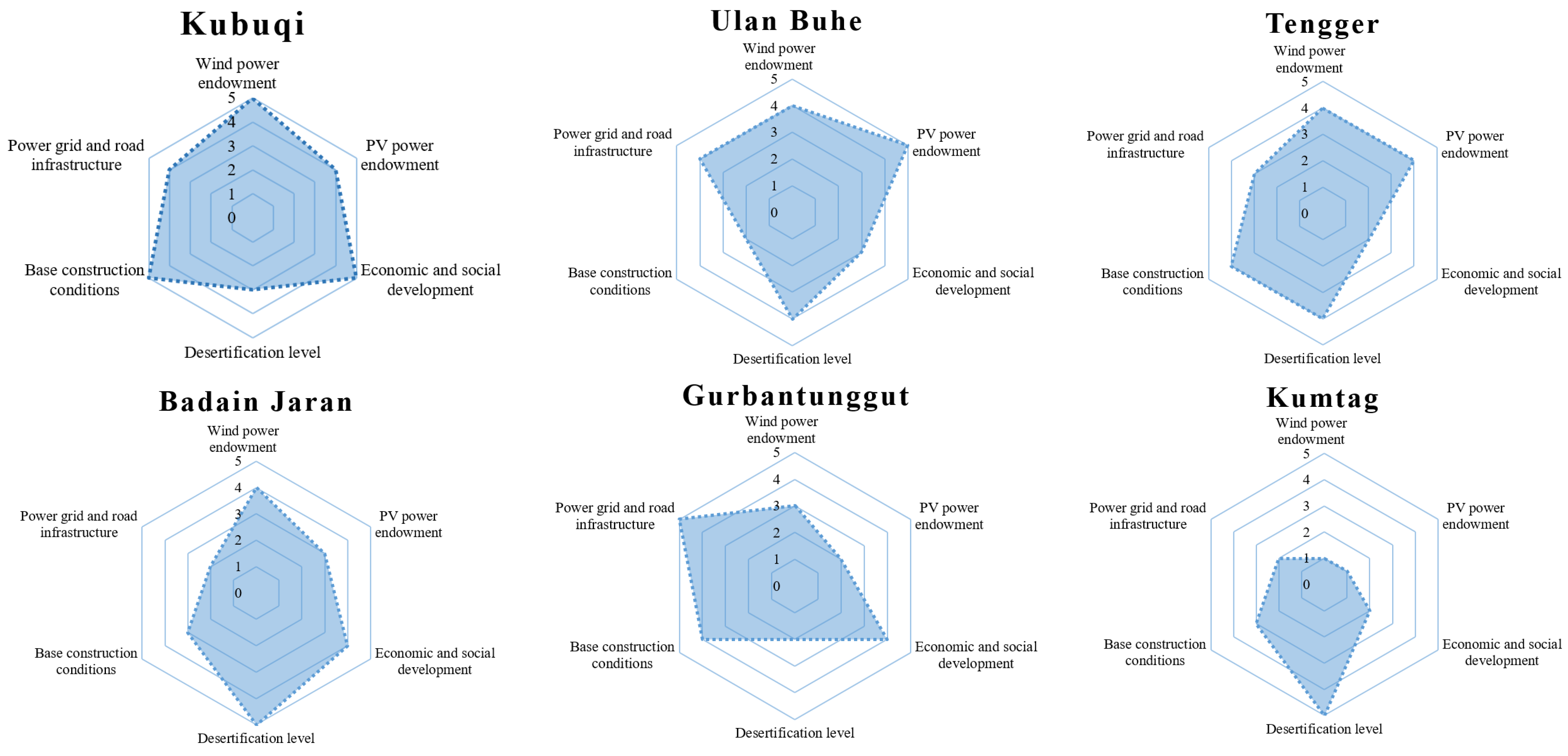

4. Wind–PV Collaborative Development Considering Meteorological Characteristics
4.1. Necessity of Wind–PV Collaborative Development
4.2. Meteorological–Electrical Division
4.3. Case Study of Across-Division Development
5. Discussion and Conclusions
- (1)
- Renewable energy development in desert–Gobi–wilderness areas is the best choice under multiple considerations. First, the key to accelerating the clean transformation in China is the large-scale development of RE, while the wind and solar resources are mainly concentrated in the northern and western areas, especially in the vast desert–Gobi–wilderness areas. Second, with the continuous progress of power generation technology, the cost is falling rapidly. Third, the energy density of the unit land area for wind or PV power generation is low, so the base construction needs a large area. In particular, the land occupation area of a PV power station with the same power generation is about five to 10 times that of wind farms and 200–300 times that of thermal power plants. As the population and economic activities in eastern and central China are concentrated, land resources specially provided for wind and PV bases are very limited. The vast desert–Gobi–wilderness areas have high wind speed, strong irradiances, and no limitations of forestry, cultivated land, mining, water, and other restrictions, which can provide sufficient land space, while achieving efficient land use, promoting local economic development and helping desert control.
- (2)
- The desert–Gobi–wilderness areas are rich in wind and PV resources and will be the key development areas in the near future. In this paper, seven deserts including Kubuqi, Ulan Buh, Tengger, Badain Jaran, Gurbantunggut, Kumtag, and Qaidam and two Gobi regions in Hainan prefecture of Qinghai Province and the northern foot of the Tianshan Mountains were selected to carry out resource assessment and development potential calculations. The total amount of wind technical installed capacity was more than 600 GW, and the total amount of PV was more than 10,700 GW. Considering the edge of the desert area, along the highway, villages, and other densely populated areas as the priority development area, the wind energy development potential was about 120 GW, with full load hours of 2513, and the PV development potential was about 1.2 TW, with full load hours of 1759. According to the economic level in 2025, the average costs of wind and PV power development were 0.28 CNY/kWh and 0.20 CNY/kWh. Furthermore, with the development of large-scale and low-speed wind turbines and the improvement of operation and maintenance technology in desert–Gobi–wilderness areas, the full load hours especially in the low-wind areas will increase, and the LCOE will decline obviously.
- (3)
- The influence of meteorological–electrical divisions will effectively enhance the collaborative benefits of RE development. Therefore, the rational layout of large-scale wind and PV power bases in vast spaces could reduce the volatility of power generation. So, the intuitive and visual understanding of resource characteristics and geographical distributions is key. In this paper, based on the massive long-term meteorological data, combined with the EOF and spatial clustering analysis methods, the wind and PV resource meteorological–electrical characteristic divisions in China were proposed for the first time. Moreover, with a case study in the Kubuqi and Qaidam Deserts, the collaborative development of wind–wind and wind–PV resources across different meteorological–electrical divisions reduced the capacity requirement of long-term energy storage from 1.815 GW to 0.755 GW, with a decline of 58%, and the total system LCOE decreased from 0.488 CNY/kWh to 0.445 CNY/kWh, nearly 10%.
Author Contributions
Funding
Data Availability Statement
Conflicts of Interest
References
- Global Energy Interconnection Development and Cooperation Organization. The Road to Global Carbon Neutrality; China Electric Power Press: Beijing, China, 2021. [Google Scholar]
- Zhuo, Z.; Du, E.; Zhang, N.; Nielsen, C.P.; Lu, X.; Xiao, J.; Wu, J.; Kang, C. Cost increase in the electricity supply to achieve carbon neutrality in China. Nat. Commun. 2022, 13, 3172. [Google Scholar] [CrossRef] [PubMed]
- IPCC. Special Report on Global Warming of 1.5 °C; Cambridge University Press: Cambridge, UK, 2018. [Google Scholar]
- IRENA. Global Energy Transformation: A Roadmap to 2050; International Renewable Energy Agency: Masdar City, Abu Dhabi, 2018. [Google Scholar]
- Sun, W.; Xiao, J.; Hou, J.; Jin, C.; Nie, Y. Investment Cost Forecasting for Low Carbon Power System Planning Considering Technical Progress and Scale Effect. IEEE Access 2022, 10, 114153–114164. [Google Scholar] [CrossRef]
- Hou, J.; Sun, W.; Xiao, J.; Jin, C.; Du, E.; Huang, J. Collaborative Optimization of Key Technology Progress and Low Carbon Transition of Power System. Autom. Electr. Power Syst. 2022, 46, 1–9. (In Chinese) [Google Scholar]
- Global Energy Interconnection Development and Cooperation Organization. Research on Asian Renewable Energy Development and Investment; China Electric Power Press: Beijing, China, 2020. [Google Scholar]
- Interpretation of Implementation Plan on Promoting High-Quality Development of New Energy in the New Era. China Electric Power News, 31 May 2022.
- Wang, Q.D. New energy development model of Inner Mongolia under the new situation. North. Econ. 2022, 7, 17–20. [Google Scholar]
- Hao, W. Continuous policy support and continuous heating up of scenic large base construction. New Energy Sci. Technol. 2022, 9, 35–36. [Google Scholar]
- Wuming, Y.; Gang, L. New methods, new ideas and new achievements in the research of exploitable capacity of Xinjiang wind and solar power resource. Wind Energy 2022, 7, 56–62. [Google Scholar]
- Yuan, J. Wind energy in China: Estimating the potential. Nat. Energy 2016, 1, 16095. [Google Scholar] [CrossRef]
- Kwon, S.D. Uncertainty analysis of wind energy potential assessment. Appl. Energy 2010, 87, 856–865. [Google Scholar] [CrossRef]
- Yang, L.; Gao, X.; Lv, F.; Hui, X.; Ma, L.; Hou, X. Study on the local climatic effects of large photovoltaic solar farms in desert areas. Sol. Energy 2017, 144, 244–253. [Google Scholar] [CrossRef]
- Chang, R.; Yan, Y.; Wu, J.; Wang, Y.; Gao, X. Projected PV plants in China’s Gobi Deserts would result in lower evaporation and wind. Sol. Energy 2023, 256, 140–150. [Google Scholar] [CrossRef]
- Heusinger, J.; Broadbent, A.M.; Sailor, D.J. Georgescu. Introduction, evaluation and application of an energy balance model for photovoltaic modules. Sol. Energy 2020, 195, 382–395. [Google Scholar] [CrossRef]
- Li, Y.; Kalnay, E.; Motesharrei, S.; Rivas, J.; Kucharski, F.; Kirk-Davidoff, D.; Zeng, N. Climate model shows large-scale wind and solar farms in the Sahara increase rain and vegetation. Science 2018, 361, 1019–1022. [Google Scholar] [CrossRef] [Green Version]
- Zhu, R.; Wang, Y.; Xiang, Y.; Sun, C.; Chang, R.; Hu, G.; Gao, Z. Study on climate characteristics and development potential of wind resources in China. Acta Energy Sol. Sin. 2021, 42, 409–418. [Google Scholar]
- China Meteorological Administration. The Detail Investigation and Assessment Report of Wind Energy Resource in China; Meteorological Press: Beijing, China, 2014; Volume 3, pp. 86–90, 108–122. [Google Scholar]
- Sun, L.; Fang, M.; Song, Z.; Yi, X. Analysis of Solar Energy Resources and Research on Investment Potential in China. Energy Sci. Technol. 2022, 20, 9–14+18. [Google Scholar]
- Zhao, Q.; Zhang, R.; Song, X.; Yu, S. Analysis on the Distribution and Output Characteristics of Wind Power and Photovoltaic Resources in Guizhou Province. Water Power 2022, 48, 81–91. [Google Scholar]
- Kumar, A.; Sah, B.; Singh, A.R.; Deng, Y.; He, X.; Kumar, P.; Bansal, R.C. A review of multi criteria decision making (MCDM) towards sustainable renewable energy development. Renew. Sustain. Energy Rev. 2017, 69, 596–609. [Google Scholar] [CrossRef]
- Latinopoulos, D.; Kechagia, K. A GIS-based multi-criteria evaluation for wind farm site selection. A regional scale application in Greece. Renew. Energy 2015, 78, 550–560. [Google Scholar] [CrossRef]
- Chaouachi, A.; Covrig, C.F.; Ardelean, M. Multi-criteria selection of offshore wind farms: Case study for the Baltic States. Energy Policy 2017, 103, 179–192. [Google Scholar] [CrossRef]
- Coppin, P.A.; Ayotte, K.A.; Steggel, N. Wind Resource Assessment in Australia–A Planners Guide; Wind Energy Research Unit, CSIRO: Canberra, Australian, 2003. [Google Scholar]
- Alpine Windharvest. Development of Information Base Regarding Potentials and the Necessary Technical, Legal and Socio-Economic Conditions for Expanding Wind Energy in the Alpine Space; Alpine Windharvest Partnership Network: Salzburg, Austria, 2005. [Google Scholar]
- Rodrigo, J.S.; Arroyo RA, C.; Witha, B.; Dörenkämper, M.; Gottschall, J.; Avila, M.; Sile, T. The New European Wind Atlas Model Chain. J. Phys. Conf. Ser. 2020, 1452, 12087. [Google Scholar] [CrossRef]
- Yu, W.; Benoit, R.; Girard, C.; Glazer, A.; Lemarquis, D.; Salmon, J.R.; Pinard, J.P. Wind Energy Simulation Toolkit (WEST): A Wind Mapping System for Use by the Wind Energy Industry. Wind Eng. 2006, 30, 15–33. [Google Scholar] [CrossRef]
- Troen, I.; Petersen, E.I. European Wind Atlas; Roskilde Riso National Laboratory: Roskilde, Denmark, 1989. [Google Scholar]
- Ayotte, K.W.; Davy, R.J.; Coppin, P.A. A Simple Temporal and Spatial Analysis of Flow in Complex Terrain in the Context of Wind Energy Modelling. Bound.-Layer Meteorol. 2001, 98, 275–295. [Google Scholar] [CrossRef]
- Davidson, M.R.; Zhang, D.; Xiong, W.; Zhang, X.; Karplus, V.J. Modelling the potential for wind energy integration on China’s coal-heavy electricity grid. Nat. Energy 2016, 1, 16086. [Google Scholar] [CrossRef]
- Ye, L.; Chen, X.Y.; Jin, J.X. Measure-Correlate-Predict Assessment Method of Wind Energy Resource Considering Wind Power Density and Wind Direction. Autom. Electr. Power Syst. 2019, 43, 24–32. [Google Scholar]
- Hermann, S.; Miketa, A.; Fichaux, N. Estimating the Renewable Energy Potential in Africa: A GIS-Based Approach; International Renewable Energy Agency: Masdar City, Abu Dhabi, 2014. [Google Scholar]
- International Renewable Energy Agency. Estimating the Renewable Energy Potential in Africa [R/OL]. (2014-8-1) [2021-1-18]. Available online: https://www.Irena.org/publications/2014/Aug/Estimating-the-Renewable-Energy-Potential-in-Africa-A-GIS-based-approach (accessed on 29 August 2022).
- Albadi, M.H.; El-Saadany, E.F. Wind Power in Ontario: An Economical Valuation. In Proceedings of the 2007 IEEE Canada Electrical Power Conference, Montreal, QC, Canada, 25–26 October 2007. [Google Scholar] [CrossRef]
- Shen, Y.; Wang, X.; Cong, R.; Lu, Q. Eco-geographical zoning of deserts and gobi in China. J. Arid Land Resour. Environ. 2013, 27, 1–13. [Google Scholar]
- 1:10000000 Scale Desertification Land Distribution Mapset of China, Produced by China Aero Geophysical Survey and Remote Sensing Center for Land and Resources and released by China Geological Survey. Available online: http://westdc.westgis.ac.cn (accessed on 29 August 2022).
- Lin, L.; Chen, Y.; Ma, W.; Lin, Z.; Yu, Q. Evolution and driving forces of ecosystem pattern in Kubuqi Desert of northern China. J. Beijing For. Univ. 2021, 43, 108–123. [Google Scholar]
- Peng, J.; Naiang, W.; Hongyi, C. A study on the range and area of Ulan Buh Desert based on 3S technology. J. Arid Land Resour. Environ. 2015, 29, 131–138. [Google Scholar]
- Feng, Y.M.; Wu, B.; Zhou, N.; Che, T.T.; Wang, F.; Cong, R.C.; Lu, Q. Gobi Classification system based on remote sensing image recognition. J. Desert Res. 2013, 33, 635–641. [Google Scholar]
- Liu, J.; Nie, H.; Xiao, C.; Shang, B.; Li, W.; Ji, X. Evolution of sandy desertification in North China from 2010 to 2018. Geol. Surv. China 2021, 8, 25–34. [Google Scholar]
- Yang, G.; Sun, X.; Hu, D.; Suo, X.; Shao, M.; Cao, C. The application of GRACE data to the analysis of the temporal and spatial changes of water reserves and the drought characteristics of Qaidam Basin. J. Navig. Position. 2023, 11, 107–112. [Google Scholar]
- Xv, Y.; Liu, B.; Sun, A.; Wang, K.; Li, D.; Zhao, H. Research progress of Holocene environmental evolution in the Gurbantuggut Desert and its surrounding areas. Arid. Land Geogr. 2023, 46, 550–562. [Google Scholar]
- Global Energy Interconnection Development and Cooperation Organization. Research on Global Renewable Energy Development and Investment; China Electric Power Press: Beijing, China, 2020. [Google Scholar]
- Wu, J.; Xiao, J.; Hou, J.; Sun, W.; Li, P.; Lyu, X. A multi-criteria methodology for wind energy resource assessment and development at an intercontinental level: Facing low-carbon energy transition. IET Renew. Power Gener. 2023, 17, 480–494. [Google Scholar] [CrossRef]
- Global Energy Interconnection Development and Cooperation Organization. The Development and Outlook of Clean Energy Power Generation Technology; China Electric Power Press: Beijing, China, 2020. [Google Scholar]
- Niu, D.; Sun, L.; Zhou, Y.; Li, P.; Tian, Z.; Wu, J.; Sun, W. Investment estimation model of medium to large-sized hydropower projects based on GRA-IPSO-BPNN. J. Glob. Energy Interconnect. 2020, 4, 404–411. [Google Scholar]
- Wu, J.; Xiao, J.; Hou, J.; Zhang, J.; Jin, C.; Han, R. Generation Potential and Economy Analysis of Green Hydrogen in China. In Proceedings of the 2022 IEEE 5th International Electrical and Energy Conference (CIEEC), Nanjing, China, 27 May 2022; pp. 4477–4482. [Google Scholar]
- World Meteorological Organization. 2022 State of Climate Services: Energy; World Meteorological Organization: Geneva, Switzerland, 2022. [Google Scholar]
- Wang, J.; Wang, Y.; Yan, C.; Qi, Y. 1:100000 Scale Desert Distribution Mapset of China, Provided by Environmental & Ecological Science Data Center for West China, National Natural Science Foundation of China. Available online: http://westdc.westgis.ac.cn (accessed on 29 August 2022).
- François, B.; Hingray, B.; Raynaud, D.; Borga, M.; Creutin, J.D. Increasing climate-related-energy penetration by integrating run-of-the river hydropower to wind/solar mix. Renew. Energy 2016, 87, 686–696. [Google Scholar] [CrossRef]
- Jin, C.; Xiao, J.; Hou, J.; Jiang, H.; Zhang, J.; Lv, X.; Shi, X. Cross-regional electricity and hydrogen deployment research based on coordinated optimization: Towards carbon neutrality in China. Energy Rep. 2022, 8, 13900–13913. [Google Scholar] [CrossRef]
- Jin, C.; Ren, D.; Xiao, J.; Hou, J.; Du, E.; Zhou, Y. Optimization Planning on Power System Supply-Grid-Storage Flexibility Resource for Supporting the “Carbon Neutrality” Target of China. Electr. Power 2021, 54, 164–174. [Google Scholar]
- Jiang, H.; Du, E.; Jin, C. Optimal planning of multi-time scale energy storage capacity of cross-national interconnected power system with high proportion of clean energy. Proc. CSEE 2021, 41, 2101–2115. [Google Scholar]
- Zhang, N.; Dai, H.; Hu, Z.; Shen, B. A source-gridload coordinated planning model considering system flexibility constraints and demand response. Electr. Power 2019, 52, 61–69. [Google Scholar]
- Xu, T.H.; Lu, Z.X.; Qiao, Y.; An, J. High penetration of renewable energy power planning considering coordination of source-load-storage multi-type flexible resources. J. Glob. Energy Interconnect. 2019, 2, 27–34. [Google Scholar]
- Du, E.; Zhang, N.; Kang, C.; Xia, Q. A high-efficiency network-constrained clustered unit commitment model for power system planning studies. IEEE Trans. Power Syst. 2018, 34, 2498–2508. [Google Scholar] [CrossRef]

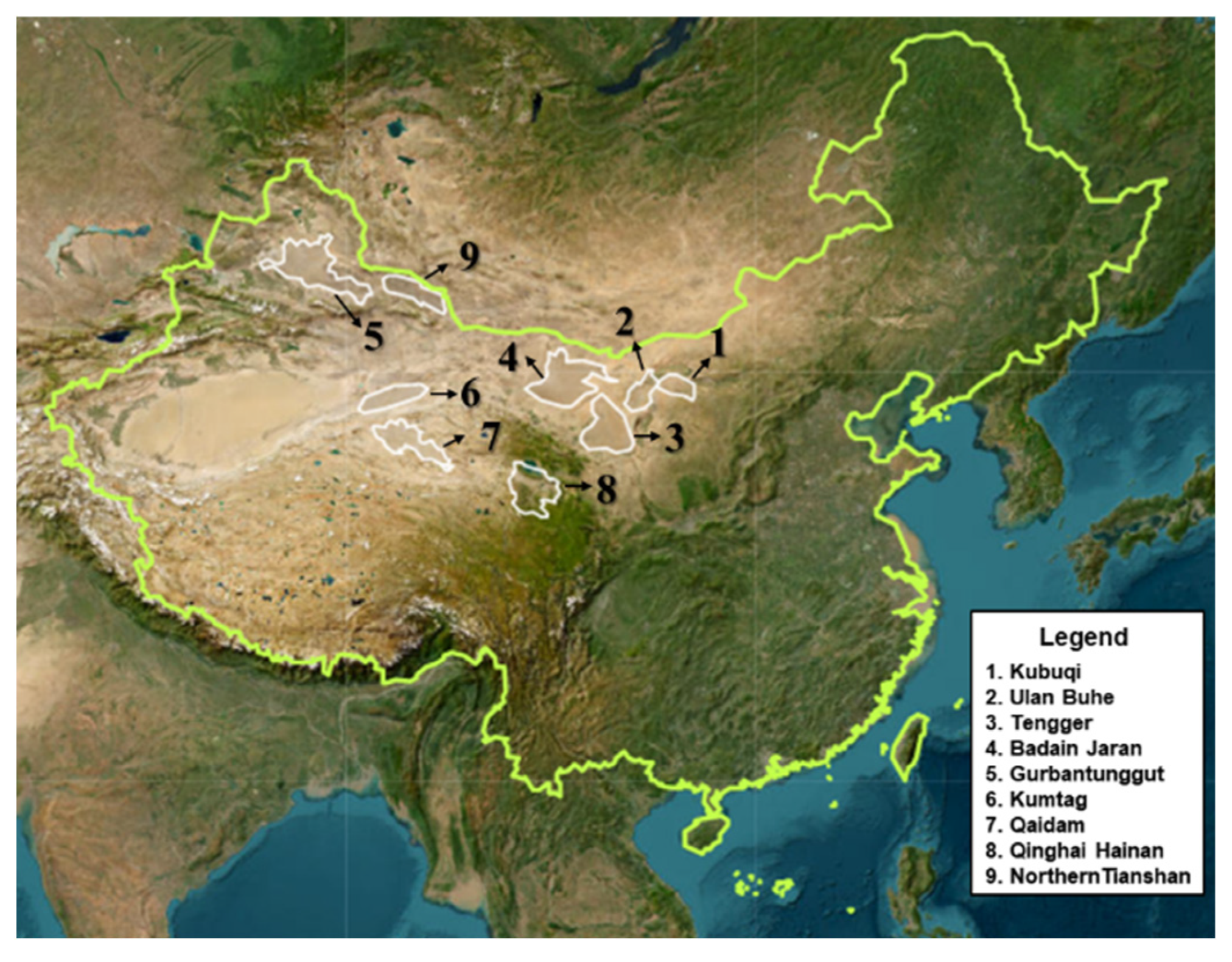
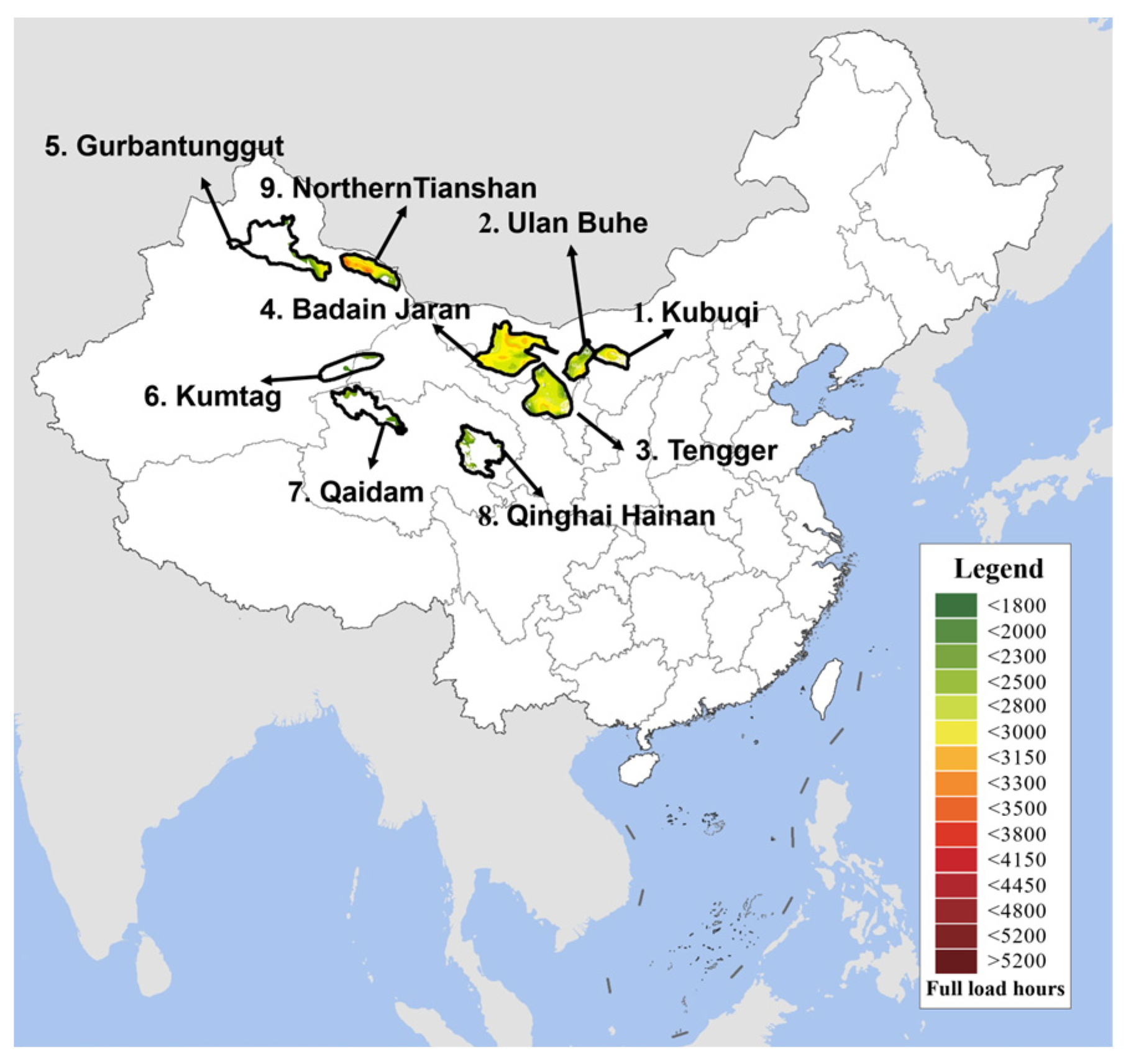
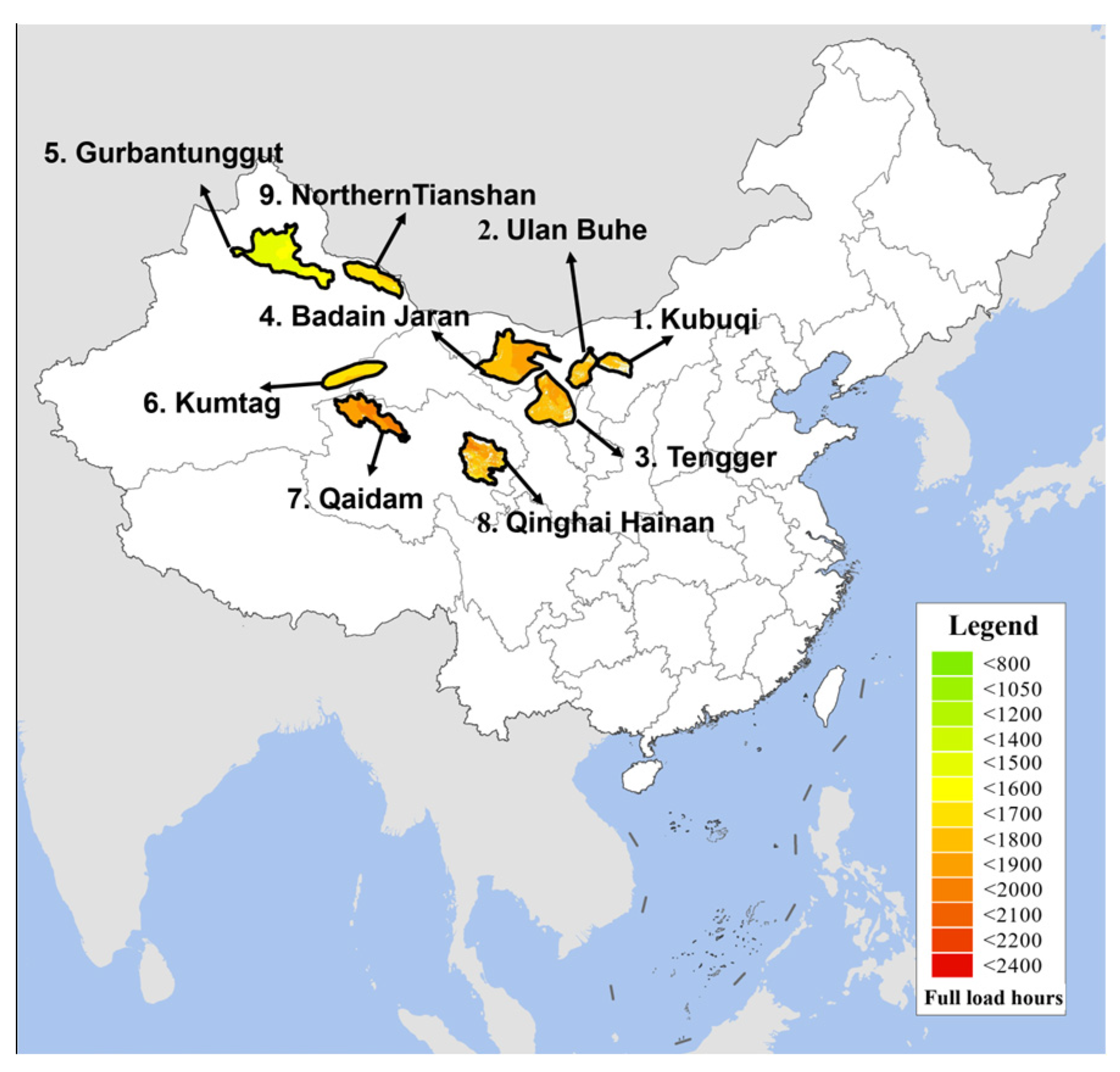

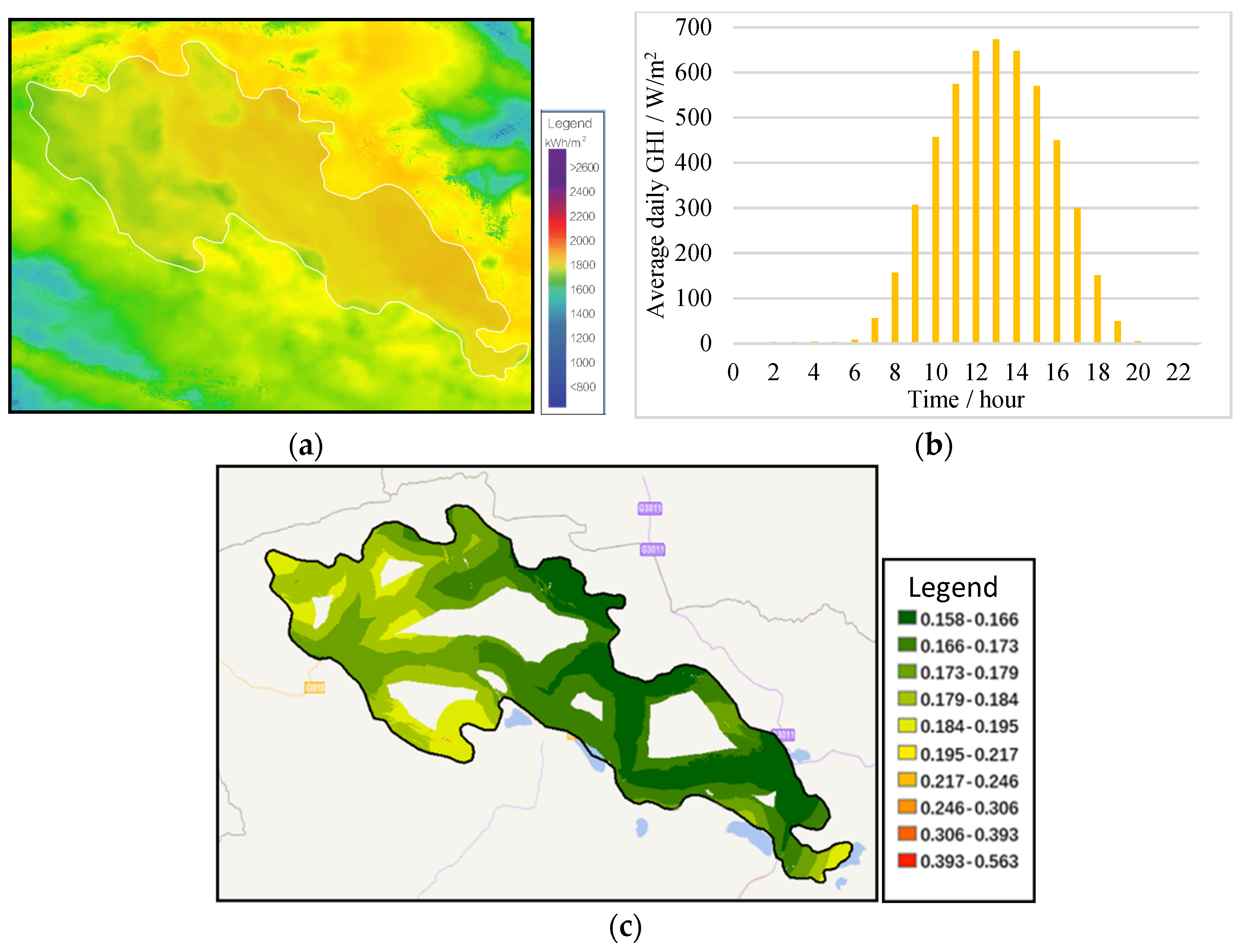
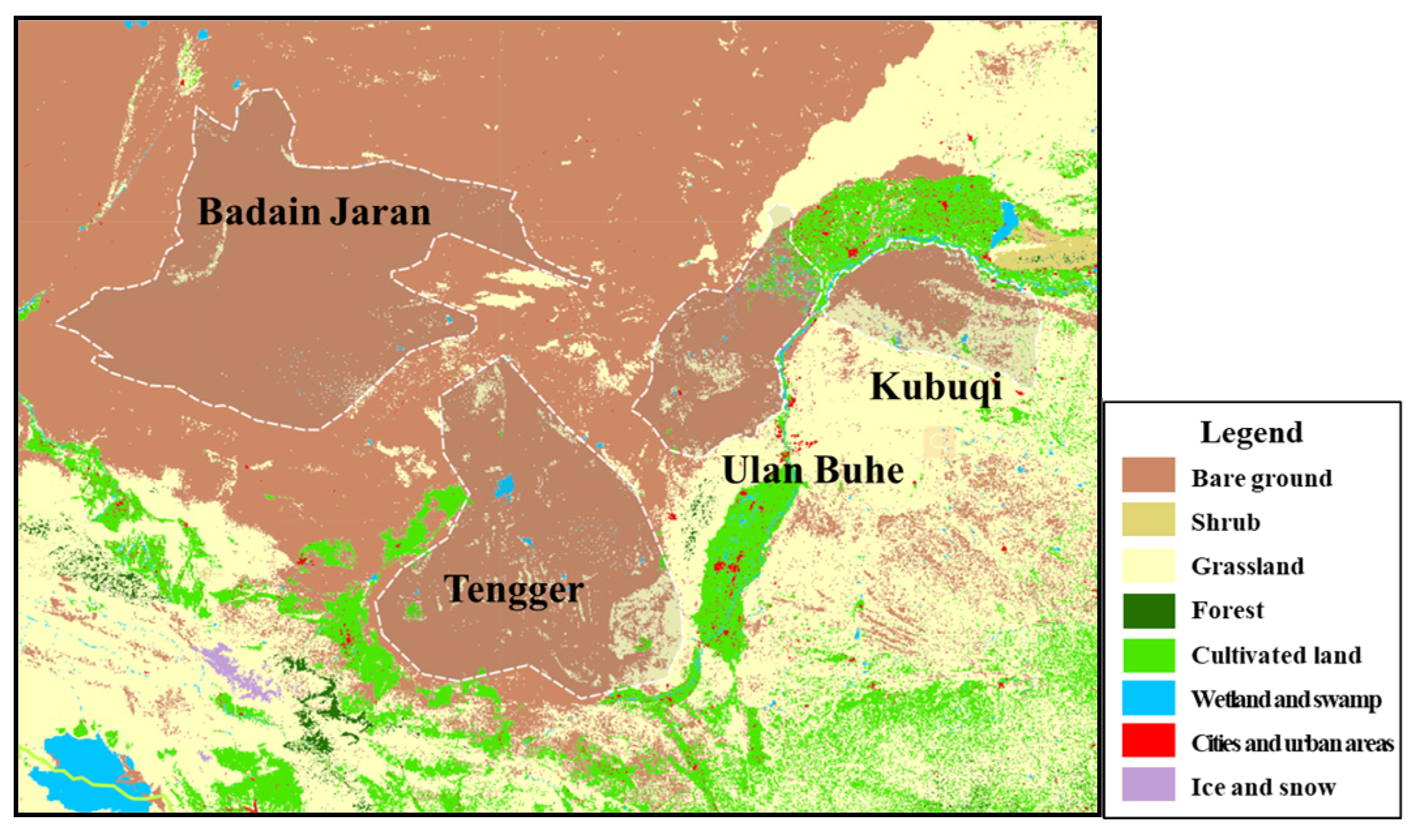


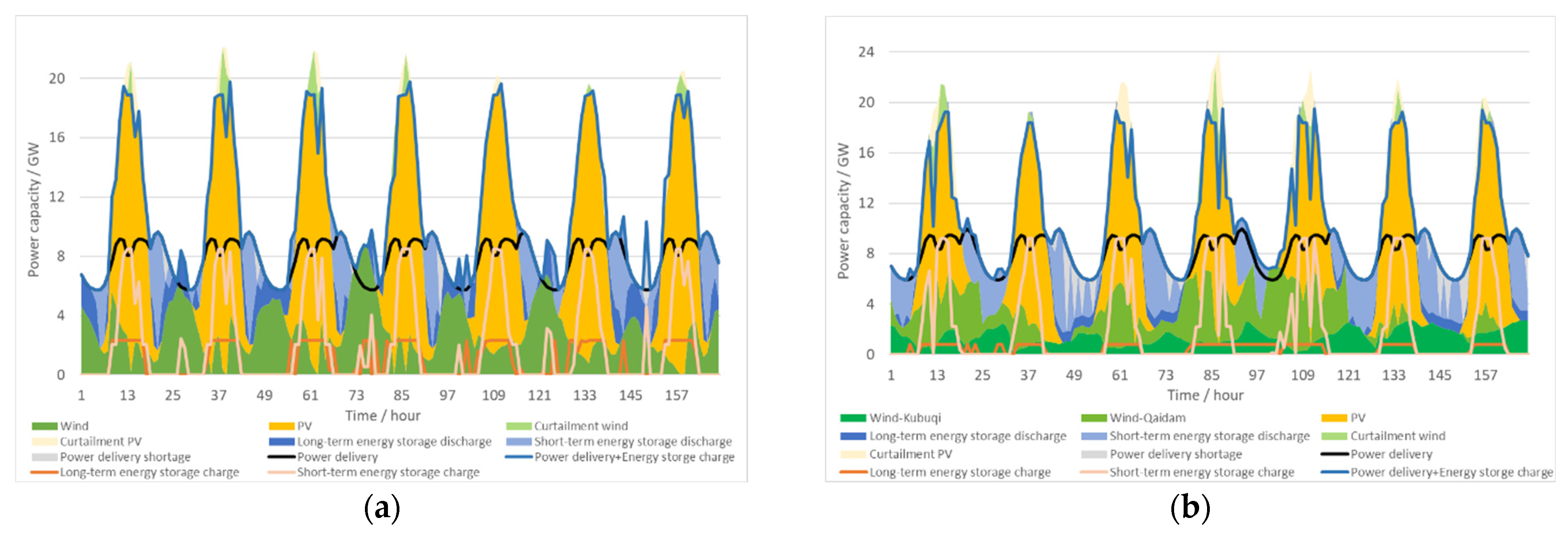

| Type | Restriction | Threshold Value | Land Use Coefficients η | |
|---|---|---|---|---|
| Wind | PV | |||
| Resource restrictions | Annual average wind speed | >5 m/s | - | - |
| Global horizontal irradiance | >1000 kWh/m2 | - | - | |
| Technical development restrictions | Wind land elevation | <4000 m | - | - |
| PV land elevation | <4500 m | |||
| Conservation area restrictions | Natural ecosystem | Unsuitable | 0% | 0% |
| Wildlife | Unsuitable | 0% | 0% | |
| Natural relics | Unsuitable | 0% | 0% | |
| Natural resources | Unsuitable | 0% | 0% | |
| Others | Unsuitable | 0% | 0% | |
| Land cover restrictions | Bare ground | Suitable | 100% | 100% |
| Shrub | Suitable | 100% | 100% | |
| Grassland | Unsuitable | 0% | 0% | |
| Forest | Unsuitable | 0% | 0% | |
| Cultivated land | Unsuitable | 0% | 0% | |
| Wetland and swamp | Unsuitable | 0% | 0% | |
| Cities and urban areas | Unsuitable | 0% | 0% | |
| Ice and snow | Unsuitable | 0% | 0% | |
| GIS Slope | - | >30° | 0% | 0% |
| Number | Investment Composition for Wind Resources | Total Cost (CNY/kW) | Investment Composition for PV Resources | Total Cost (CNY/kW) |
|---|---|---|---|---|
| 1 | Equipment and installation cost | 4144 | Equipment and installation cost | 3087 |
| 1.1 | Generator and blade | 2912 | PV module | 1400 |
| 1.2 | Tower | 525 | Support bracket | 357 |
| 1.3 | Installation | 182 | Installation | 749 |
| 1.4 | Others | 525 | other | 581 |
| 2 | Construction and others | 1393 | Construction and others | 161 |
| 2.1 | Foundation and other buildings | 665 | Management costs | 14 |
| 2.2 | Management costs | 161 | Design fee | 35 |
| 2.3 | Others | 567 | Others | 112 |
| Total | 5537 | Total | 3248 | |
| Number | Financial Parameters | Wind | PV |
|---|---|---|---|
| 1 | Loan term | 7 years | 7 years |
| 2 | Loan proportion | 70% | 70% |
| 3 | Loan rate | 3% | 3% |
| 4 | Construction period | 1 year | 1 year |
| 5 | Service life | 20 years | 20 years |
| 6 | Residual value proportion | 0% | 0% |
| 7 | Operation and maintenance proportion | 3.5% | 1.5% |
| Name | Total Area (km2) | Wind Speed (m/s) | Technical Installed Capacity (GW) | Priority Development with Distance of 5 km | LCOE (CNY/kWh) | |||
|---|---|---|---|---|---|---|---|---|
| Development Area (km2) | Development Potential (MW) | Full Load Hours | ||||||
| 1 | Kubuqi | 12,518 | 6.4 | 31.3 | 1404 | 6808 | 2428 | 0.26 |
| 2 | Ulan Buh | 15,525 | 6.04 | 58.5 | 3666 | 16,615 | 2487 | 0.27 |
| 3 | Tengger | 42,678 | 6.2 | 164.2 | 3066 | 14,380 | 2426 | 0.28 |
| 4 | Badain Jaran | 51,614 | 6.48 | 170.1 | 6657 | 29,031 | 2760 | 0.28 |
| 5 | Gurbantunggut | 50,536 | 4.84 | 45.0 | 2336 | 10,784 | 2274 | 0.3 |
| 6 | Kumtag | 22,688 | 4.99 | 11.3 | 519 | 2060 | 2230 | 0.34 |
| 7 | Qaidam | 35,007 | 5.25 | 27.5 | 2400 | 10,216 | 2051 | 0.34 |
| 8 | Qinghai Hainan | 43,559 | 5.38 | 15.2 | 2196 | 6540 | 2049 | 0.33 |
| 9 | Northern Tianshan | 20,308 | 6.42 | 80.6 | 4361 | 19,078 | 2824 | 0.25 |
| Total | 294,433 | 5.7 | 603.6 | 26,605 | 1,155,112 | 2513 | 0.28 | |
| Name | GHI (kWh/km2) | Technical Installed Capacity (GW) | Priority Development with Distance of 5 km | LCOE (CNY/kWh) | |||
|---|---|---|---|---|---|---|---|
| Development Area (km2) | Development Potential (MW) | Full Load Hours | |||||
| 1 | Kubuqi | 1711 | 280 | 1404 | 8630 | 1770 | 0.19 |
| 2 | Ulan Buh | 1739 | 548 | 2129 | 90,850 | 1781 | 0.19 |
| 3 | Tengger | 1730 | 1690 | 1038 | 47,530 | 1783 | 0.20 |
| 4 | Badain Jaran | 1760 | 1930 | 2593 | 102,870 | 1793 | 0.22 |
| 5 | Gurbantunggut | 1463 | 1550 | 8442 | 83,700 | 1491 | 0.24 |
| 6 | Kumtag | 1679 | 900 | 1313 | 51,990 | 1691 | 0.24 |
| 7 | Qaidam | 1821 | 1670 | 4307 | 210,520 | 1876 | 0.18 |
| 8 | Qinghai Hainan | 1672 | 1520 | 10,104 | 445,440 | 1801 | 0.19 |
| 9 | Northern Tianshan | 1637 | 642 | 4797 | 148,510 | 1674 | 0.22 |
| Total | 1677 | 10,730 | 36126 | 1,190,040 | 1759 | 0.20 | |
| Collaborative Development Plans | Plan 1: Wind and PV in Kubuqi, with Energy Storage (4 h, 90% Efficiency) | Plan 2: Wind and PV in Kubuqi, Wind in Qaidam, with Energy Storage (4 h, 90% Efficiency) | ||
|---|---|---|---|---|
| Technical indicators | Transmission scale (MW) | 10,000 | 10,000 | |
| Transmission full load hours | 6000 | 6000 | ||
| Guarantee rate | 95% | 95% | ||
| Curtailment rate | 10% | 10% | ||
| Capacity (GW) | Renewable energy | 13 GW wind and 28 GW PV in Kubuqi | 6 GW wind in Qaidam and 7.2 GW wind and 28.3 GW PV in Kubuqi | |
| Energy storage capacity | Short term | 8.5 | 9 | |
| Long term | 1.815 | 0.755 | ||
| Cost and full load hour | LCOE (CNY/kWh) | 0.488 | 0.445 | |
| Energy storage cost (CNY/kWh) | 0.669 | 0.590 | ||
| Energy storage hours | Short term | 1057 | 994 | |
| Long term | 3849 | 3898 | ||
| Annual cost of wind and PV power (billion CNY) | 14.95 | 15.08 | ||
| Annual cost of energy storage equipment (billion CNY) | 12.60 | 8.81 | ||
Disclaimer/Publisher’s Note: The statements, opinions and data contained in all publications are solely those of the individual author(s) and contributor(s) and not of MDPI and/or the editor(s). MDPI and/or the editor(s) disclaim responsibility for any injury to people or property resulting from any ideas, methods, instructions or products referred to in the content. |
© 2023 by the authors. Licensee MDPI, Basel, Switzerland. This article is an open access article distributed under the terms and conditions of the Creative Commons Attribution (CC BY) license (https://creativecommons.org/licenses/by/4.0/).
Share and Cite
Wu, J.; Xiao, J.; Hou, J.; Lyu, X. Development Potential Assessment for Wind and Photovoltaic Power Energy Resources in the Main Desert–Gobi–Wilderness Areas of China. Energies 2023, 16, 4559. https://doi.org/10.3390/en16124559
Wu J, Xiao J, Hou J, Lyu X. Development Potential Assessment for Wind and Photovoltaic Power Energy Resources in the Main Desert–Gobi–Wilderness Areas of China. Energies. 2023; 16(12):4559. https://doi.org/10.3390/en16124559
Chicago/Turabian StyleWu, Jiawei, Jinyu Xiao, Jinming Hou, and Xunyan Lyu. 2023. "Development Potential Assessment for Wind and Photovoltaic Power Energy Resources in the Main Desert–Gobi–Wilderness Areas of China" Energies 16, no. 12: 4559. https://doi.org/10.3390/en16124559






